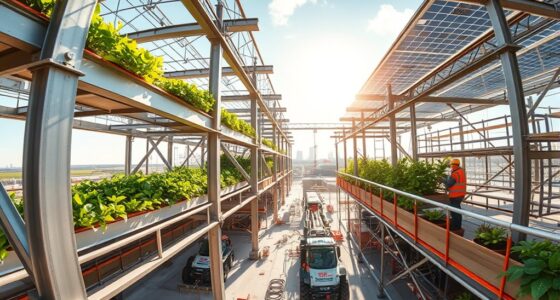Youth climate lawsuits are powerful tools where young people take governments to court to push for stronger climate action. They argue that inaction violates their rights and fails to protect future generations. These cases challenge slow policies and hold leaders accountable for climate change. By using legal systems, youth activists aim to achieve enforceable change and inspire others to get involved. Discover how these legal struggles are shaping climate justice and what they mean for your future.
Key Takeaways
- Youth climate lawsuits challenge governments to adopt stronger, legally binding climate policies and hold them accountable for inaction.
- Young plaintiffs argue that current policies violate their rights and threaten their future well-being, prompting legal action.
- These lawsuits utilize constitutional and human rights frameworks to pressure authorities for urgent climate commitments.
- Youth-led legal cases have set significant precedents, demonstrating the power of young people in shaping climate justice.
- Courts serve as a tool to bypass political gridlock, enforce climate laws, and ensure meaningful, enforceable climate action.

Youth climate lawsuits are increasingly challenging governments and corporations to take stronger action on climate change. As a young person, you might feel frustrated by the slow pace of climate policy developments and the lack of urgent action to protect your future. These lawsuits are a form of legal activism that puts pressure on authorities to prioritize climate change and hold them accountable for their inaction. By stepping into the courtroom, youth are transforming their concerns into powerful legal challenges that demand tangible change.
When you become involved in a youth climate lawsuit, you’re engaging in more than just a legal battle — you’re making a statement that the current climate policies are insufficient. Many of these cases argue that governments and companies have a duty to safeguard the environment and future generations, citing constitutional rights, human rights, or international agreements. You’re fundamentally telling policymakers that their inaction violates your rights, and that they need to do more to curb emissions, protect natural resources, and promote sustainable development. These lawsuits often aim to force governments to strengthen climate policies, set stricter emission reduction targets, or implement more inclusive climate plans.
Legal activism through youth-led lawsuits emphasizes that climate change isn’t just an environmental issue — it’s a legal and moral one. By taking your case to court, you’re asserting that climate change threatens your well-being and futures, and that legal systems have a role in driving meaningful change. This approach can be very effective because courts have the power to compel governments and corporations to change their policies or face legal consequences. It’s a way to bypass political gridlock and push for immediate, enforceable action.
Your involvement in these lawsuits also highlights how important it is for young people to stand up and be heard. It shows that you’re willing to use the legal system as a tool for advocacy and change. Many successful youth climate lawsuits have set important precedents, encouraging more legal activism worldwide. They demonstrate that even individuals and small groups can challenge powerful entities when backed by strong legal arguments and a commitment to justice. Ultimately, these lawsuits underscore the necessity of holding leaders accountable and reshaping climate policies to secure a sustainable future for everyone. Your voice and legal activism can help push the world toward the urgent action needed to address climate change effectively. Recognizing that climate change involves complex legal frameworks is crucial for understanding how these lawsuits can create meaningful impact.
Frequently Asked Questions
How Successful Have Youth Climate Lawsuits Been Historically?
When you look at youth activism’s impact through legal strategies, youth climate lawsuits have seen mixed success historically. Some cases, like Juliana v. United States, have made significant strides by holding governments accountable and raising awareness. Others face setbacks, but overall, these lawsuits have shifted public discourse and inspired further activism. Your involvement in such efforts can continue to push for meaningful change, proving that young voices matter in climate justice.
What Legal Grounds Do Kids Typically Use in These Cases?
When you look at these cases, kids often challenge environmental legislation by arguing they have legal standing, meaning their rights are directly affected by climate policies. They may claim that governments’ actions or inactions threaten their future well-being and environmental rights. By using legal standing, they aim to hold authorities accountable, asserting that current laws fail to protect their right to a safe and sustainable environment.
Are There Age Restrictions for Youth Plaintiffs in Climate Lawsuits?
You might wonder if age restrictions limit youth plaintiffs’ legal standing in climate lawsuits. Generally, courts recognize that minors can have legal standing if they demonstrate a direct stake in the case, so age restrictions aren’t strict barriers. Courts focus on whether the youth have a genuine interest or harm to address, making age less of a hurdle than you might think. Your age doesn’t automatically disqualify you from participating.
How Do Courts Evaluate the Scientific Evidence Presented?
When courts evaluate scientific evidence, they rely on scientific standards to determine its credibility. You should know that judges scrutinize how well the evidence supports claims and whether experts agree on findings. They look for peer-reviewed studies, reliable data, and sound methodology. This process guarantees the evidence meets rigorous scientific standards, helping courts make fair decisions based on trustworthy information about climate change impacts and the need for action.
What Long-Term Impacts Have These Lawsuits Achieved?
You see climate activism shaping the future, and these lawsuits drive real change. They push governments to strengthen policies, protect the environment, and hold leaders accountable. Long-term impacts include increased awareness, policy reforms, and a generation inspired to fight for sustainability. These actions show that youth-led legal efforts can create lasting change, proving that persistence in climate activism fosters a healthier planet for generations to come.
Conclusion
Your voice is becoming a powerful storm for change, sweeping through courts and challenging governments to act. These youth climate lawsuits are like seeds of hope, pushing for a healthier planet for tomorrow. By standing up today, you’re planting the roots for a future where the air is cleaner, and the Earth is protected. Keep fighting—your courage is the spark igniting a brighter, greener world. Together, you’re turning the tide toward hope.










